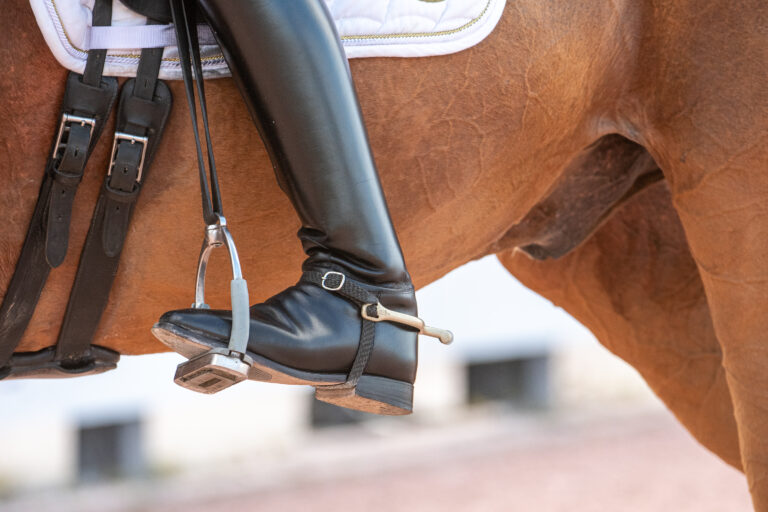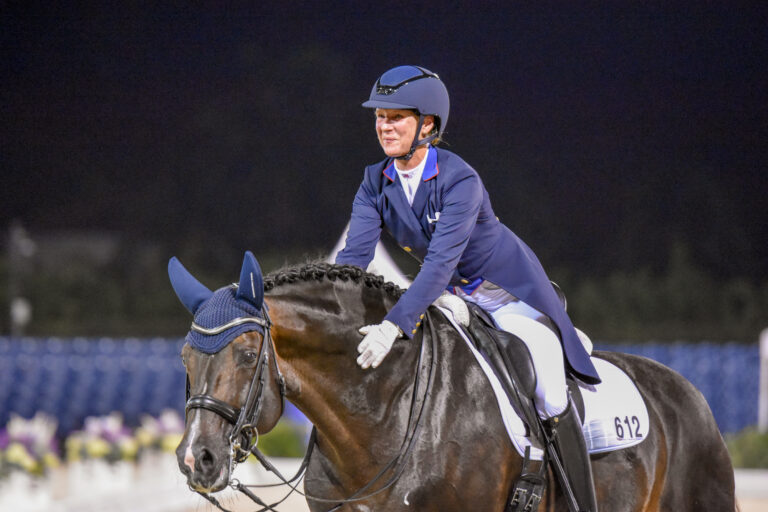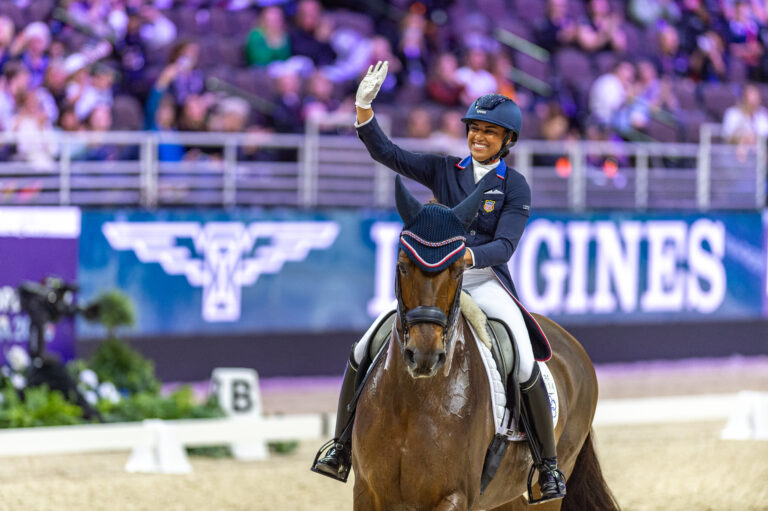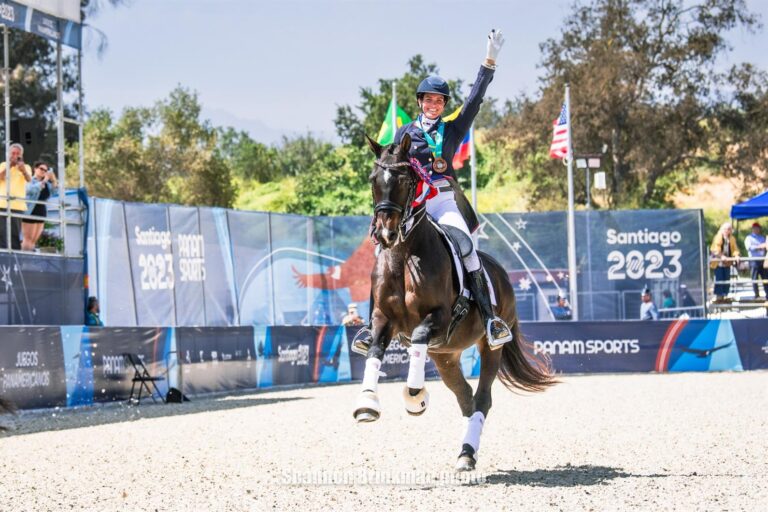Call it the WEG effect. The FEI World Equestrian Games earlier this month was the focus of so many riders for so long that they and their horses needed a break before starting back on the competition trail.
So it was probably no surprise that the Dressage at Devon Grand Prix ranks were thinner than usual, with eight in the featured Saturday night musical freestyle and only three in the Grand Prix Special. Even the Canadians who usually make this show a “must” stop didn’t appear in the numbers they often do.
As former U.S. dressage team chef d’equipe Jessica Ransehousen pointed out, it wasn’t just the riders who made it to WEG who were taking a break. So many riders who weren’t included on their countries’ teams also spent a lot of energy chasing a spot on the squads, she noted.
And not only that. As Lori Kaminiski, Dressage at Devon’s president and CEO noted, “people who might show are going to WEG as spectators and then they don’t have the money to go to the next show.”
Even so, “It didn’t affect us as much as we thought it might,” said Lori.
“Our mix was different this year. So overall our numbers in performance were not down. It was just a different mix of competitors. We had a huge PSG (Prix St. Georges),” she said.
The enthusiastic crowd, a trademark of the show, was as engaged as usual for the freestyle, always made more dramatic by the lighting. When they spotted something they liked, they acknowledged it, even in the middle of a test, and they showed love to the competitors—even though the big names who often participate weren’t around this weekend.
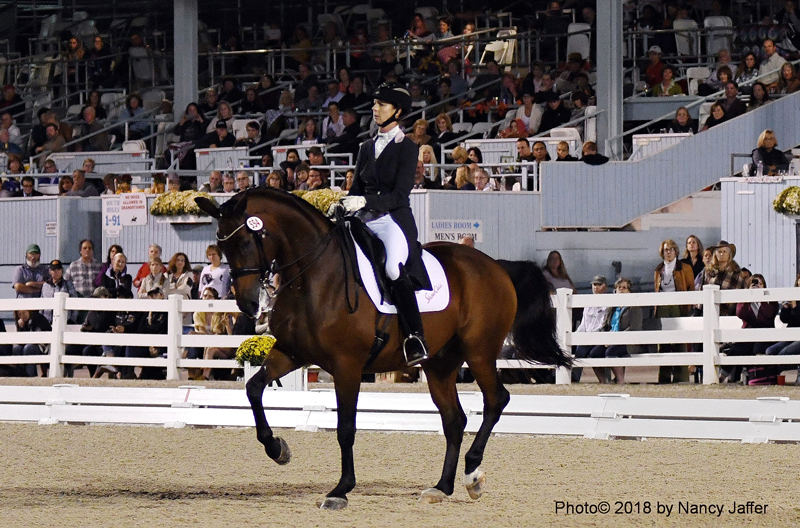
The advantage of not seeing familiar faces in the freestyle was the opportunity for others to make their mark. Jessica Jo Tate has been coming to Devon for 22 years, and Saturday night marked her first freestyle victory, as she earned a mark of 73.650 percent with Faberge to a soundtrack of the “pop classical” Rondo Veneziano.
JJ, whose South Carolina farm hosted the U.S. silver medal WEG dressage team the week before the competition, loved being in the Dixon Oval.
“There’s a certain special energy that I think makes it one of the most special shows because it’s so much like Europe. The crowd tonight was really behind the riders and loved the performances and that makes it so special to have the honor to compete here,” said J.J.
To hear more of her thoughts, click on this video:
JJ has been riding Faberge, a son of Floristan I, for 10 years and noted with a fond smile, “I talked a lot about him having a heart of gold but I think he’s fully made of gold.“ Their bond is strong. After suffering what was called “a career ending injury” when he was nine or ten, Faberge had his rehab taken over by JJ, who brought him back.
There was no question about what runner-up Nicole Harrington’s music was for her black gelding, Wizard of Oz. Can you guess? It was a montage of the songs we all know from the movie, along with some cackling from the wicked witch. Wizard “just loved it. That’s what he wanted and that’s what he got, ” said Nicole. The music inspired an entertaining freestyle to which the judges gave 70.750 percent.

The German-bred Hanoverian by Weltmeyer was sold to Bulgaria when he was five. But his breeder bought him back “because of poor riding.” Nicole, who lives in Ohio, brought him as a PSG horse to be a resale project who “turned out to be a really fun horse who is not really for sale.”

Third place went to Kim Herslow, whose music included Taylor Swift, Adele and the Bang Bang Song. She characterized it as “just fun.” Of Soraya, a Sandro Hit daughter who was part of the Finnish team in the 2013 European championships, Kim explained, “This is her first CDI freestyle and we’ve ridden that maybe four or five times total. I’m just happy she came in here and handled the atmosphere.”
In the qualifier, Kim played it conservative. But before the freestyle, she thought, “You know what? I’m just going to go for it. I thought, `Okay.’ I just dropped my hand down centerline and did the passage back up to the judge with one hand. The crowd loved it. And she (Soraya) started getting like,`Woo this is fun, everybody likes it.’ I think it was the most fun freestyle I’ve ever done.” She was rewarded with a mark of 70.275 percent.

Fourth place went to Adiah HP, a brown-and-white pinto cross between a Friesian and a Dutch warmblood, ridden by James Koford. With dark-colored horses dominating the evening, Adiah stood out, but didn’t quite manage to break 70 percent, finishing on 69.625. Still, the crowd just loved her.
JJ called Dressage at Devon “such an amazing, incredible show,” but even in non-WEG years, it would be good to have more high-performance entries. As the calendar has changed and more shows have been added, traditional destinations sometimes have suffered. The fact that so many people go to Florida each season, where they can compete in CDI (international) classes to their hearts’ content, means the schedule for a number of riders has changed over the last few years.
Lori said there had been a thought about changing the date of Dressage at Devon, but others users rule out the spring and summer, as well as the fact that you can’t have an east coast breed final in July.
“We feel our relevance maybe isn’t what it used to be,” she said, but noted, “People still want to come to Devon,” saying it is the highlight of the season for Northeast riders.
Even so, George Williams, president of the U.S. Dressage Federation, wants to see more top U.S. and Canadian dressage riders compete at Devon. He feels it is vital “to save the show as a special venue.”
“I believe there is a need for this show in this area,” he commented.” I think the amateur division and the amount of support it gets is great and it still is a destination for a lot of people,” he continued, referring to spectators.
At the same time, he would like to see the show regain its former importance, noting the footing is good, but more prize money would help. While George thinks a circuit of several shows including Dressage at Devon would be a good idea, he acknowledged that the New England Dressage Association Show, which runs before Devon, has its problems. This year, there was only one grand prix rider and just six in the CDI section of that New York fixture.
“A lot of people went to WEG,” said NEDA President Phyllis LeBlanc. “A lot of people are doing their qualifying in Florida. They can go to a horse show every weekend, so it changes the nature of things. What is important to us at NEDA is to try to have that level of riding for everybody at the show to see and enjoy. It’s great to have those role models and examples in front of you. Not everyone can go down to Florida. We’d like to keep a CDI in New England so people can see that kind of fabulous riding. That’s our challenge.”
Key dressage shows in the Northeast and midAtlantic areas are “crucial for the development and promotion of dressage,” George suggested, saying shows in the region “have a tremendous impact on the amount of interest in the sport. Florida is terrific, but we need other venues.” Of Devon, he added, “Make sure it continues and make sure it gets better. To me, those are almost synonymous. I think in order to keep going, to keep attracting, you have to have your star athletes.”
For results of the performance portion of Dressage at Devon, click on this link.


